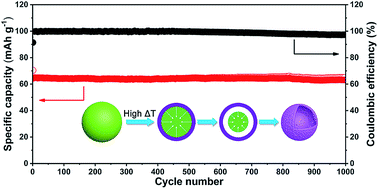Yolk–shell Nb2O5 microspheres as intercalation pseudocapacitive anode materials for high-energy Li-ion capacitors†
Abstract
Lithium-ion capacitors (LICs) are receiving extensive attention due to their high energy/power densities. However, the imbalance in reaction kinetics between the sluggish diffusion-limited insertion anode and rapid surface-controlled capacitive cathode always leads to limited power density and poor cycling properties. Herein, yolk–shell structured orthorhombic phase Nb2O5 microspheres (YS-Nb2O5) are prepared via a scalable spray drying method employing niobium oxalate hydrate as the precursor. The as-prepared YS-Nb2O5 exhibits high specific capacity (211 mA h g−1 at 0.5C) and superior rate capability. LICs based on the YS-Nb2O5 anode and activated carbon (AC) cathode are also assembled. The YS-Nb2O5//AC LIC devices exhibit ultrahigh energy (173 W h kg−1) and power (10.8 kW kg−1) densities with ideal cycling stability (∼98% capacity retention for 1000 cycles). This work provides significant insight into the reasonable design of pseudocapacitive anode materials for high-performance LICs.



 Please wait while we load your content...
Please wait while we load your content...